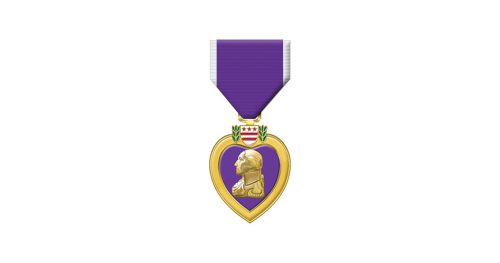NORTH READING — As an official Purple Heart Community, North Reading will commemorate national Purple Heart Day on Thursday, August 7.
On that day, townspeople will see the town’s Purple Heart flag being flown on the Town Common flag pole beneath the Stars and Stripes and the bandstand on the Town Common will also be lit with purple lights, according to Rich Stratton, chair of the North Reading Veterans Events Committee
This commemoration is held to honor the town’s 33 Purple Heart recipients for their service and sacrifice.
Among them are three servicemen who were killed in action during the Vietnam War—Daniel D. Callahan, U.S. Army; Jimmie M. Couto, U.S. Marine Corps; and Eugene R. Moreau, U.S. Army.
North Reading is also home to three servicemen who received two Purple Hearts for their sacrifices on the battlefield, all of whom fought during the Vietnam War. They are Gerald “Jay” Gurry, U.S. Army (who also was awarded a Bronze Star), and the late Neal Rooney, U.S. Army and the late John Wiklanski, U.S. Army.
The list of the town’s Purple Heart recipients spans from WWII through the Global War on Terror (GWOT). They are:
Bayard Aims, Jr. – Army: Korea; Michael Bartlett – Army: Iraq; Robert Berglund – Army: WWII; Daniel D. Callahan – Army-KIA: Vietnam; Richard J. Campbell – Army: WWII; Walter Carpenter – Army: WWII; Ralph J. Cidlevicz – Navy: WWII; Jimmie M. Couto – Marine Corps-KIA: Vietnam; Charles R. Cutcliffe – Army: WWII; Thomas F. Flynn – Army: WWII; John Graupner – Army: Vietnam; Gerald “Jay” Gurry – Army: Vietnam 2PH; Lloyd Hay – Army: WWII; Jon Homer – Army: WWII;
As well as, Robert F. Mahan – Navy: WWII; Shawn MacPherson – Army: GWOT; Sidney McIntire – Army: WWII; Eugene R. Moreau – Army-KIA: Vietnam; Edward Miller – Army: WWII; William Moss – Army: GWOT; Paul Perreault – Army: WWII; Elwood Richardson, Jr. – Army: WWII; Robert R. Richardson – Army: Korea; Neal Rooney – Army: Vietnam 2PH; Daniel J. Scott, Jr. – Army: WWII; Bernard Scott – Army: WWII; John Steber – Army: WWII; Edward Swauger – Army: Vietnam; Robert Swenson – Marine Corps: Vietnam; Robert E. Turner – Army: WWII; Raymond Veader – Army: Vietnam; Charles J. Warren – Army: WWII and John Wiklanski – Army: Vietnam 2PH.
HISTORY OF THE PURPLE HEART
The following is a brief history of the Purple Heart based on information provided by the National Purple Heart Hall of Honor (https://www.thepurpleheart.com/history/):
“The award known as the Purple Heart has a history that reaches back to the waning days of the American Revolution. The Continental Congress had forbidden General George Washington from granting commissions and promotions in rank to recognize merit. Yet Washington wanted to honor merit, particularly among the enlisted soldiers. On August 7, 1782, his general orders established the Badge of Military Merit: … ‘The General ever desirous to cherish virtuous ambition in his soldiers, as well as to foster and encourage every species of Military merit directs whenever any singularly meritorious action is performed, the author of it shall be permitted to wear on his facings, over his left breast, the figure of a heart in purple cloth or silk edged with narrow lace or binding.’”
This award was open only to enlisted men (Privates, Corporals and Sergeants) and granted them the distinction of being permitted to pass all guards and sentinels as could commissioned-officers. The names of the recipients were to have been kept in a “Book of Merit” (which has never been recovered).
At the present time there are three verified recipients of the Badge of Military Merit: Sergeant Elijah Churchill, 2nd Continental Dragoons; Sergeant William Brown, 5th Connecticut Continental Line Infantry and Sergeant Daniel Bissel, 2nd Connecticut Continental Line Infantry.
Washington stated that the award was to be a permanent one, but once the Revolution ended, the Badge of Military Merit was all but forgotten until the 20th century.
General John J.”Blackjack” Pershing suggested a need for an award for merit in 1918, but it was not until 1932 that the modern Purple Heart was created in recognition of Washington’s ideals and for the bicentennial of his birth. General Order #3 announced the establishment of the award:
“… By order of the President of the United States, the Purple Heart, established by General George Washington at Newburgh, August 7, 1782, during the War of the Revolution is hereby revived out of respect to his memory and military achievements. By order of the Secretary of War: Douglas MacArthur, General, Chief of Staff.
“…The Purple Heart has undergone many changes with respect to the criteria for being awarded. At first, the Purple Heart was exclusively awarded to Army and Army Air Corps personnel and could not be awarded posthumously to the next of kin. In 1942, President Franklin Roosevelt signed an executive order allowing the Navy to award the Purple Heart to Sailors, Marines, and Coast Guard personnel. Also in that year, the Purple Heart was made available for posthumous awarding to any member of the Armed Forces killed on or after December 6, 1941.
“Originally the Purple Heart was awarded for merit. Being wounded was considered to be one type of merit. With the creation of the Legion of Merit in 1942, the award of the Purple Heart for merit became unnecessary and was therefore discontinued. Currently, the Purple Heart, per regulation is awarded in the name of the President of the United States to any member of the Armed Forces of the United States who, while serving under competent authority in any capacity with one of the U.S. Armed Services after April 5, 1917 has been wounded, killed, or has died after being wounded by enemy action.”

